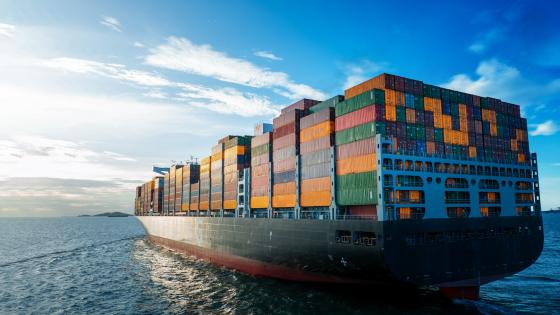As global producers, service providers, and international financial institutions are becoming increasingly intertwined through expanding supply chains (Baldwin 2016), it is feared now more than ever that disastrous economic shocks can rapidly spread from country to country through these complex networks. The fragility of global production networks is particularly concerning as the frequency and severity of natural disasters is projected to increase due to climate change (Milly et al. 2002)and evolving seismic trends (Beroza 2012).
Supply chains the propagation of shocks
Supply chains can spread and amplify shocks caused by natural disasters. Focusing on American firms between 1978 and 2013, Barrot and Sauvagnat (2016)showed that the sales of domestic supply partners of disaster-stricken firms declined after each disaster event. Similarly, Carvalho et al. (2016)found that shocks caused by the Great East Japan Earthquake propagated to other Japanese firms in regions not directly hit by the disaster. Boehm et al. (2015)expanded the scope of this field of research to international shock propagation and found that overseas affiliates of Japanese firms directly affected by the Great East Japan Earthquake were also negatively affected.
Our recent work further extends the global focus in this research agenda and examines international propagation of shocks through global supply chains in general, not restricted to propagation between affiliated firms (Kashiwagi et al. 2018). We have also compared intra-national and international patterns of disaster shock propagation and found stark differences.
Such analysis has become possible with new firm-level datasets collected by FactSet Revere from open sources, including financial reports, news articles, and websites. FactSet Revere data cover 110,000 global firms (including 17,656 in the US) and their supply-chain networks. The supply chain data were partly obtained from financial reports, as publicly listed firms in some countries (such as the US) are required to report their major customers. The global production network captured in this dataset is visualised in Figure 1. To gain more information about each firm, we have supplemented the supply chain data with Osiris, a worldwide dataset of mostly publicly listed firms collected by Bureau van Dijk.
Figure 1 Global supply chains
Source: Authors.
We focused on economic shocks caused by Hurricane Sandy that hit the east coast of the US in October 2012. The hurricane caused an economic loss of US$50 billion (Center for Research on the Epidemiology of Disasters 2017)and, as a result of this disaster, exports from seaports in New York and New Jersey declined for several months (United States Census Bureau 2017).
We examined how post-disaster sales of firms that were not directly hit by the hurricane depended on whether their suppliers and customers were located in the disaster areas. Our results show that after the hurricane, sales growth of US firms linked with a supplier or customer in the disaster areas was on average 10% points lower than that of firms not linked with any firm in the disaster areas, suggesting substantial intra-national shock propagation. This is consistent with the results found in Barrot and Sauvagnat (2016)and Carvalho et al. (2016).
However, we find that the sales growth of firms outside the US linked with any supplier or customer in the disaster areas was not lower than that of others. In other words, the negative shock by the hurricane did not seem to propagate outside the US. The lack of international propagation is remarkable especially considering that the damage caused by Hurricane Sandy was significantly larger than the vast majority of US disasters studied between 1978 and 2013, which were found to trigger shocks to the domestic partners of the directly damaged firms (Barrot and Sauvagnat 2016). This leads us to think that if a large disaster like Sandy did not significantly affect overseas partners, few disasters would.
Why did the disaster shocks propagate within the US but not beyond its borders? Investigating the propagation mechanism in more detail revealed that the hurricane impacts did not spread to US firms which had foreign suppliers or customers. In other words, firms linked with partners in the disaster areas were not affected by the negative shock, if their production network was internationalised, regardless of whether they were located in or outside the US. Internationalised firms are generally known to be more productive (Bernard et al. 2007)and have better access to information about global markets (Chaney 2014). Therefore, it is likely that firms embedded in international production networks can more easily substitute partners whose operations have been hampered by a disaster.
We also found that firms whose partners were connected to each other were more negatively affected by disaster shocks. In such dense networks, negative shocks seem more likely to circulate and even become amplified. This type of highly interconnected networks of suppliers and customers can typically be found in the form of ‘keiretsu’groups among Japanese manufacturers, such as the Toyota Motor Corporation and its direct and indirect suppliers (Aoki 1988). Although dense interfirm networks usually promote trust among member organisations, encourage information sharing, and thus improve productivity, our results show that they are vulnerable to economic shocks.
The findings imply that supply chain links with diverse partners, including partners overseas and partners that are not linked to each other, increase firms’ resilience to propagation of negative economic shocks. These findings do not seem to be limited to Hurricane Sandy – positive effects of diversified supply chains and trans-local links on disaster resilience were also observed after the Great East Japan Earthquake in another study (Todo et al. 2015).
Concluding remarks
Protectionism is on the rise around the world, fuelled by concerns of negative international impacts on domestic economies, firms, and workers. In contrast, our research highlights a mechanism through which global interfirm linkages can strengthen domestic economic players in the face of natural disasters.
Access to global opportunities and to alternative partners can be a source of resilience against disaster shocks for internationalised firms. While international economic links may be feared to conduct and amplify global shocks, our study illustrates how international networks can protect firms during turbulent times.
References
Aoki, M (1988), Information, Incentives and Bargaining in the Japanese Economy: A Microtheory of the Japanese Economy, Cambridge University Press.
Baldwin, R (2016), The Great Convergence, Belknap Press.
Barrot, J-N and J Sauvagnat (2016), "Input Specificity and the Propagation of Idiosyncratic Shocks in Production Networks", The Quarterly Journal of Economics 131(3):1543-1592.
Bernard, A B, J B Jensen, S Redding, and P K Schott (2007), "Firms in International Trade", Journal of Economic Perspectives 21(3): 105-130.
Beroza, G C (2012), "How Many Great Earthquakes Should We Expect?" Proceedings of the National Academy of Sciences 109(3): 651-652.
Boehm, C, A Flaaen, and N Pandalai-Nayar (2015)l "Input Linkages and the Transmission of Shocks: Firm-Level Evidence from the 2011 Tōhoku Earthquake", US Census Bureau Center for Economic Studies Paper No. CES-WP-15-28.
Carvalho, V M, M Nirei, Y U Saito, and A Tahbaz-Salehi (2016), "Supply Chain Disruptions: Evidence from the Great East Japan Earthquake", Columbia Business School Research Paper, 17-5.
Center for Research on the Epidemiology of Disasters (2017), Cred Emergency Events Database, Em-Dat Database.
Chaney, T (2014), "The Network Structure of International Trade", American Economic Review 104(11): 3600-3634.
Kashiwagi, Y, Y Todo, and P Matous (2018), "International propagation of economic shocks through global supply chains", WINPEC Working Paper, No. E1810, Waseda Institute of Political Economy, Waseda University (previously published as "Propagation of Shocks by Natural Disasters through Global Supply Chains," RIETI Discussion Paper, No. 18-E-041).
Milly, P C D, R T Wetherald, K A Dunne, and T L Delworth (2002), "Increasing Risk of Great Floods in a Changing Climate", Nature 415(6871): 514.
Todo, Y, K Nakajima, and P Matous (2015), "How Do Supply Chain Networks Affect the Resilience of Firms to Natural Disasters? Evidence from the Great East Japan Earthquake", Journal of Regional Science 55(2): 209-229.
United States Census Bureau (2017), USA Trade Online.






